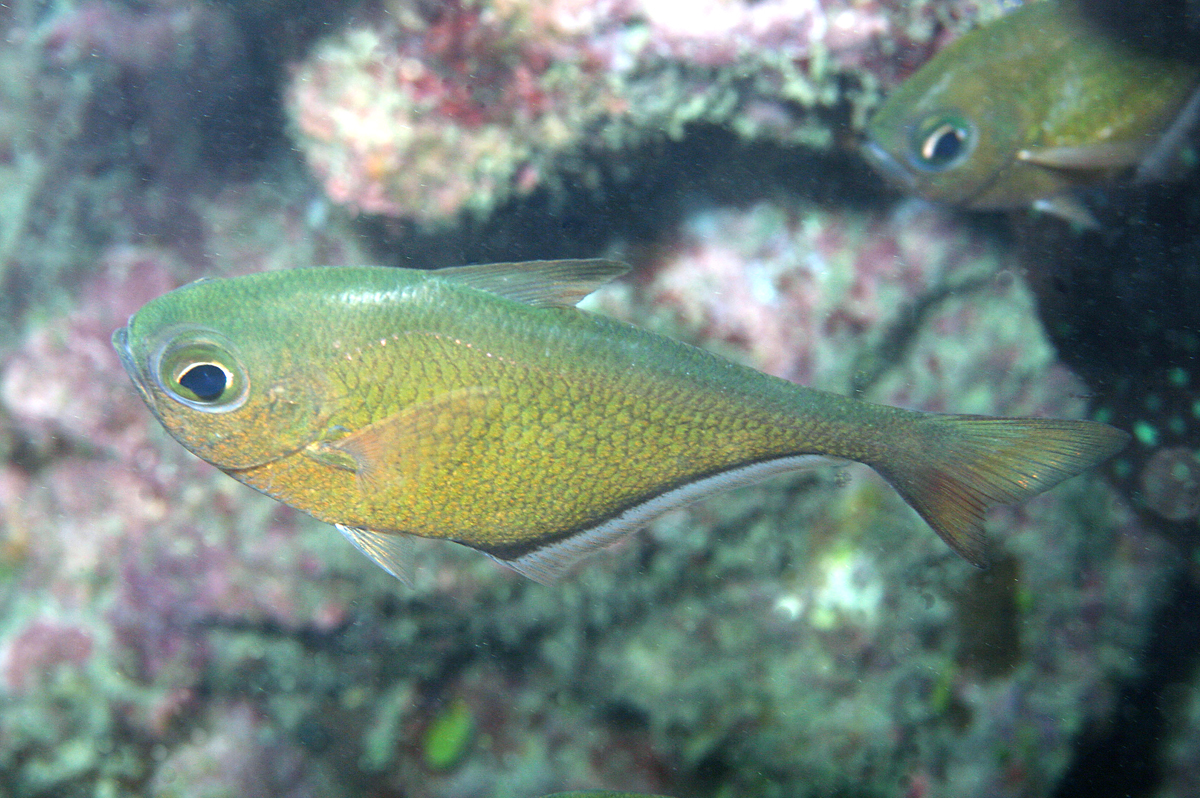Silver Bullseye, Pempheris schwenkii Bleeker 1855

Silver Bullseyes, Pempheris schwenkii, in Taiwan, 2008. Source: Robert A. Patzner / FishBase. License: All rights reserved
A small yellowish-brown bullseye with darker scale edges, a blackish leading edge on the dorsal fin and a dark brown to black band along the anal-fin base.
Koeda et al. (2014) the determined that the Silver Bullseye was restricted to eastern Australia, and that the similar Pempheris tominagai occurred on the west coast.
Silver Bullseye, Pempheris schwenkii Bleeker 1855
More Info
|
Distribution |
Houtman Abrolhos to The Kimberley, Western Australia, and the northern Great Barrier Reef to Moreton Bay, Queensland; also Lord Howe Island in the Tasman Sea. Elsewhere the species occurs in the tropical and subtropical, Indo-west-central Pacific. Inhabits coastal and offshore reefs, aggregating around large coral bommies, often finding shelter in caves, crevices and under ledges during the day. |
|
Features |
Dorsal fin VI, 9; Anal fin III, 35-42; Scales on sides cycloid, deciduous (lateral-line scales less); body depth 2.35–2.45 in SL; head length 3.2–3.3 in SL; snout length 4.6–5.1 in head length; eye large, 7.2–7.7 in SL; caudal fin length 3.3–4.5 in SL, and moderately to strongly forked, the caudal concavity 2.3–2.55 in head length; pectoral fins 3.2–3.5 in SL; prepelvic length 2.45–2.6 in SL; pelvic fins 1.8–2.05 in head length. |
|
Colour |
Variable in colour, often silvery-grey above, with a lavender iridescence, silvery sides, sometimes with coppery scale margins; a black spot on about outer third of dorsal fin, the leading edge broadly blackish; anal fin with a broad blackish band along base; about outer fourth of caudal fin blackish, the upper and lower margins blackish but about half as broad; pectoral fins with a dark bluish grey band across base. |
|
Feeding |
A nocturnal species, schooling in caves and crevices during the day, emerging to feed on zooplankton in open water at night. |
|
Remarks |
Koeda et al. (2014) suggest that specimens from Western Australia that have previously been identified Pempheris schwenkii are actually Tominaga's Sweeper, Pempheris tominagai. However, The distributions of the two species do not overlap according to Randall et al. (2014) who suggested that P. tominagai is a Red Sea endemic. Although they did not discuss Australian material, they implied that it might be P. schwenkii. |
|
Species Citation |
Pempheris schwenkii Bleeker, 1855, Natuur. Tijdschr. Neder. Indië 8: 314. Type locality: Batu Island, Indonesia. |
|
Author |
Bray, D.J. 2020 |
|
Resources |
Silver Bullseye, Pempheris schwenkii Bleeker 1855
References
Allen, G.R. 1997. Marine Fishes of Tropical Australia and South-east Asia. Perth : Western Australian Museum 292 pp. 106 pls.
Allen, G.R. & Erdmann, M.V. 2012. Reef fishes of the East Indies. Perth : Tropical Reef Research 3 vols, 1260 pp.
Allen, G.R., Hoese, D.F., Paxton, J.R., Randall, J.E., Russell, B.C., Starck, W.A., Talbot, F.H. & Whitley, G.P. 1976. Annotated checklist of the fishes of Lord Howe Island. Records of the Australian Museum 30(15): 365-454 figs 1-2 (P. 405, misidentified as Pempheris vanicolensis)
Bleeker, P. 1855. Bijdrage tot de kennis der ichthyologische fauna van de Batoe-eilanden. Natuurwetenschappelijk Tijdschrift voor Nederlandsch Indië 8: 305-328 See ref at BHL
Francis, M. 1993. Checklist of the coastal fishes of Lord Howe, Norfolk, and Kermadec Islands, southwest Pacific Ocean. Pacific Science 47(2): 136-170 figs 1-2
Johnson, J.W. 2010. Fishes of the Moreton Bay Marine Park and adjacent continental shelf waters, Queensland, Australia. pp. 299-353 in Davie, P.J.F. & Phillips, J.A. Proceedings of the Thirteenth International Marine Biological Workshop, The Marine Fauna and Flora of Moreton Bay. Memoirs of the Queensland Museum 54(3)
Koeda, K., Ishihara, t. & Tachihara, K. 2012. The Reproductive Biology of Pempheris schwenkii (Pempheridae) on Okinawa Island, Southwestern Japan. Zoological Studies 51(7): 1086-1093. PDF Open access
Koeda, K., Yoshino, T., Imai, H. & Tachihara, K. 2014. A review of the genus Pempheris (Perciformes, Pempheridae) of the Red Sea, with description of a new species. Zootaxa 3793(3): 301-330
Kuiter, R.H. 1996. Guide to Sea Fishes of Australia. A comprehensive reference for divers and fishermen. Sydney, NSW, Australia : New Holland Publishers xvii, 434 pp.
Mooi, R.D. &. Jubb, R.N. 1996. Descriptions of two new species of the genus Pempheris (Pisces: Pempheridae) from Australia, with a provisional key to Australian species. Records of the Australian Museum 48(2): 117-130
Randall, J.E., Allen, G.R. & Steene, R. 1990. Fishes of the Great Barrier Reef and Coral Sea. Bathurst : Crawford House Press 507 pp. figs.
Randall, J.E., Allen, G.R. & Steene, R. 1997. Fishes of the Great Barrier Reef and Coral Sea. Bathurst : Crawford House Press 557 pp. figs.
Randall, J.E. & Bineesh, K.K. 2014. Review of the fishes of the genus Pempheris (Perciformes: Pempheridae) of India, with description of a new species and a neotype for P. mangulaCuvier. Journal of the Ocean Science Foundation 10: 20-40 http://dx.doi.org/10.5281/zenodo.1042771
Randall, J.E. & Victor, B.C. 2015. Descriptions of thirty-four new species of Pempheris (Perciformes: Pempheridae), with a key to the species of the western Indian Ocean. Journal of the Ocean Science Foundation 18: 1-77 pp. https://doi.org/10.5281/zenodo.1045550
Randall, J.E., Victor, B.C., Alpermann, T.J., Bogorodsky, S.V., Mal, A.O., Satapoomin, U. & Bineesh, K.K. 2014. Rebuttal to Koeda et al. 2014. On the Red Sea fishes of the perciform genus Pempheris. Zootaxa 3887(3): 377–392
Russell, B.C. 1983. Annotated checklist of the coral reef fishes in the Capricorn-Bunker group, Great Barrier Reef, Australia. Great Barrier Reef Marine Park Authority. Special Publication Series 1: 1-184 figs 1-2






